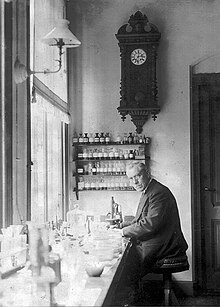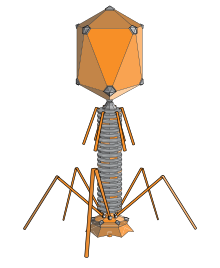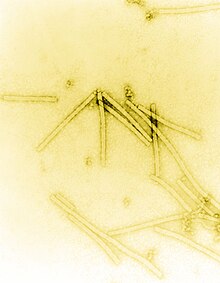User:Graham Beards/viruses/History of virology
The history of virology – the scientific study of viruses and the infections they cause – begins in the closing years of the 19th century. Although Louis Pasteur and Edward Jenner developed the first vaccines to protect against viral infections, they did not know that viruses existed.
The first evidence of the existence of viruses came from experiments with filters that had pores small enough to retain bacteria. In 1892,
Early virologists

Despite his other successes, Louis Pasteur (1822–1895) was unable to find a causative agent for rabies and speculated about a pathogen too small to be detected using a microscope.[1] In 1884, the French microbiologist Charles Chamberland (1851–1931) invented a filter – known today as the Chamberland filter – that had pores smaller than bacteria. Thus, he could pass a solution containing bacteria through the filter and completely remove them from the solution.[2] In 1892, the Russian biologist
In 1898, the Dutch microbiologist Martinus Beijerinck (1851–1931) repeated the experiments and became convinced that the filtered solution contained a new form of infectious agent.[4] He observed that the agent multiplied only in cells that were dividing and he called it a contagium vivum fluidum (soluble living germ) and re-introduced the word virus.[3] Beijerinck maintained that viruses were liquid in nature, a theory later discredited by the American biochemist and virologist Wendell Meredith Stanley (1904–1971), who proved they were particles.[3] In the same year Friedrich Loeffler (1852–1915) and Paul Frosch (1860–1928) passed the first animal virus through a similar filter and discovered the cause of foot-and-mouth disease.[5]
In 1881,
By 1928 enough was known about viruses to enable Thomas Milton Rivers (1888–1962) to write the first book about all known viruses and his Filtrable Viruses was published in 1928. Rivers, who survived typhoid fever at the age of twelve, went on to have a distinguished career in virology. He was born in Jonebro, Georgia USA, was awarded a BA degree from Emory College in 1909 and graduated in medicine at Johns Hopkins University in 1915. In 1926, he was invited to speak at a meeting organised by the Society of American Bacteriology where he said for the first time, "Viruses appear to be obligate parasites in the sense that their reproduction is dependent on living cells."[10]
That viruses were particles was not considered unnatural and fitted in nicely with the
In 1935, Wendell Stanley examined the tobacco mosaic virus and found it was mostly made of protein.
In Pasteur's day, and for many years after his death the word "virus" was used to describe any cause of infectious disease. Painstaking work, by many bacteriologists, soon discovered the cause of numerous infections. However, some infections remained, many of them horrendous, but for which no bacterial cause could be found. These agents were invisible and could only be grown in living animals. The discovery of viruses was the key that unlocked the door that withheld the secrets of the cause of these mysterious infections. And, although Koch's postulates could not be fulfilled for many of these infections, this did not stop the pioneer virologists from looking for viruses in infections for which no other cause could be found.[17]
Bacteriophages

Bacteriophages are viruses that infect bacteria. There are over 5,100 types of bacteriophages. They are important in

Discovery
Bacteriophages were discovered in the early 20th century, by the English bacteriologist
Félix d'Herelle (1873–1949) was a mainly self-taught French-Canadian microbiologist. In 1917 he discovered that "an invisible antagonist", when added to bacteria on agar, would produce areas of dead bacteria.[19] The antagonist, now known to be a
bacteriophage could pass through a Chamberland filter. He accurately diluted a suspension of these viruses and discovered that the highest dilutions (lowest virus concentrations), rather than killing all the bacteria, formed discrete areas of dead organisms. Counting these areas and multiplying by the dilution factor allowed him to calculate the number of viruses in the original suspension.[21] He realised that he had discovered a new form of virus and later coined the term
"bacteriophage".[22][23]
Between 1918 and 1921 d'Herelle discovered different types of bacteriophages that could infect several other species of bacteria including Vibrio cholera.
Early research
D'Herelle travelled widely to promote the use of bacteriophages in the treatment of bacterial infections. In 1928, he became professor of biology at Yale and founded several research institutes.[26] He was convinced that bacteriophages were viruses despite opposition from established bacteriologists such as the Nobel Prize winner Jules Bordet (1870–1961). Bordet argued that bacteriophages were not viruses but just enzymes released from "lysogenic" bacteria. He said "the invisible world of d'Herelle does not exist".[27] But in the 1930s, the proof that bacteriophages were viruses was provided by Christopher Andrews (1896–1988) and others. They showed that these viruses differed in size and in their chemical and serological properties.
In 1940, the first electron micrograph image of a bacteriophage was published and this silenced sceptics who had argued that bacteriophages were relatively simple enzymes and not viruses.[28] Numerous other types of bacteriophages were quickly discovered and were shown to infect bacteria wherever they are found. But this early research was interrupted by World War II. Even d'Herelle was silenced. Despite his Canadian citizenship, he was interned by the Vichy Government until the end of the war.[29] Knowledge of bacteriophages increased in the 1940s following the formation of the Phage Group by scientists throughout the US. Among the members was Max Delbrück (1906–1981) who founded a course on bacteriophages at Cold Spring Harbor Laboratory.[25] Other key members of the Phage Group included Salvador Luria (1912–1991) and Alfred Hershey (1908–1997). During the 1950s, Hershey and Chase made important discoveries on the replication of DNA during their studies on a bacteriophage called T2. Together with Delbruck they were jointly awarded the 1969 Nobel Prize in Physiology or Medicine "for their discoveries concerning the replication mechanism and the genetic structure of viruses".[30] Since then, the study of bacteriophages has provided insights into the switching on and off of genes, and a useful mechanism for introducing foreign genes into bacteria and many other fundamental mechanisms of molecular biology.[31]
20th century
By the end of the 19th century, viruses were defined in terms of their infectivity, their ability to be filtered, and their requirement for living hosts. Up until this time, viruses had only been grown in plants and animals, but in 1906, Ross Granville Harrison (1870–1959) invented a method for growing tissue in lymph,[32] and, in 1913, E Steinhardt, C Israeli, and RA Lambert used this method to grow vaccinia virus in fragments of guinea pig corneal tissue.[33] In 1928, HB and MC Maitland grew vaccinia virus in suspensions of minced hens' kidneys.[34] Their method was not widely adopted until the 1950s, when poliovirus was grown on a large scale for vaccine production.[35]
At the turn of the 20th century, evidence for the existence of viruses was obtained from experiments with filters that had pores too small for bacteria to pass through; the term "filterable virus" was coined to describe them.[36] Although the modern concept of a virus was at that time slowly beginning to gain acceptance, the word is ancient. In Latin it means a "slimy liquid, poison offensive odour or taste", and it first appears in the medical literature in the 18th century to describe a poisonous fluid.[37]

In 1882, Adolf Mayer (1843–1942) described a condition of tobacco plants, which he called "mosaic disease" ("mozaïkziekte"). The diseased plants had variegated leaves that were mottled.[38] He excluded the possibility of a fungal infection and could not detect any bacterium and speculated that a "soluble, enzyme-like infectious principle was involved".[39] He did not pursue his idea any further, and it was the filtration experiments of Ivanovsky and Beijerinck that suggested the cause was a previously unrecognised infectious agent. After tobacco mosaic was recognized as a virus disease, virus infections of many other plants were discovered.[39]
The importance of tobacco mosaic virus in the history of virology cannot be overstated. It was the first virus to be discovered, and the first to be
By 1935 many plant diseases were thought to be caused by viruses. In 1922,

Until the 1930s most scientists believed that viruses were small bacteria, but following the invention of the electron microscope in 1938 they were shown to be completely different, to a degree that not all scientists were convinced they were anything other than accumulations of toxic proteins. The situation changed radically when it was discovered that viruses contain genetic material in the form of DNA or RNA.[44] Once they were recognised as distinct biological entities they were soon shown to be the cause of numerous infections of plants, animals, and even of bacteria.[45]
Of the many diseases of humans that were discovered to be caused by viruses in the 20th century only one, smallpox, has been eradicated. Two others – measles and poliomyelitis – could be, but the diseases caused by viruses such as HIV and influenza virus have proved to be more difficult to control.
Late 20th century
The second half of the 20th century was the golden age of virus discovery and most of the 2,000 recognised species of animal, plant, and bacterial viruses were discovered during these years.
Table 1. Some of the many viruses that were discovered in the 20th century
21st century
As humans have changed their behaviour during the course of history, so have viruses. In ancient times the human population was too small for pandemics to occur and, in the case of some viruses, too small for them to survive. In the 20th and 21st century increasing population densities, revolutionary changes in agriculture and farming methods, and high speed travel have contributed to the spread of new viruses and the re-appearance of old ones.[93][94] Like smallpox, some viral diseases might be conquered, but others, such as SARS will continue to present new challenges.[95] Although vaccines are still the most powerful weapon against viruses, in recent decades antiviral drugs have been developed to specifically target viruses as they replicate in their hosts.[96] The 2009 influenza pandemic showed how rapidly new strains of viruses continue to spread around the world, despite our efforts to contain them.[97] Advances in virus discovery and control continue to be made.
- PMID 12758285.)
{{cite journal}}: Unknown parameter|month=ignored (help); line feed character in|journal=at position 13 (help - ^ Shors, pp.76–77
- ^ ISBN 0-340-66316-2.)
{{cite book}}: CS1 maint: multiple names: authors list (link - ISBN 1-4051-3645-6.)
{{cite book}}: CS1 maint: multiple names: authors list (link - ISBN 0-12-375146-2.
- )
- PMID 11482006.
- )
- )
- ^ Frank L. Horsfall Jnr.(1965) "Thomas Milton Rivers (1888–1962)—A biographical memoir" The National Academy of Sciences Washington D.C. Retrieved 3 December 2010.
- ^ *In 1887, Buist visualised one of the largest, Vaccinia virus, by optical microscopy after staining it. Vaccinia was not known to be a virus at that time. (Buist J.B.(1887) Vaccinia and Variola: a study of their life history Churchill, London)
- ^ From Nobel Lectures, Physics 1981–1990, (1993) Editor-in-Charge Tore Frängsmyr, Editor Gösta Ekspång, World Scientific Publishing Co., Singapore.
- ISBN 0-521-26056-6.)
{{cite book}}: CS1 maint: multiple names: authors list (link - PMID 17756690.
- PMID 17788438.
- ISBN 0-7637-5963-5.
- ISBN 0-521-26056-6.)
{{cite book}}: CS1 maint: multiple names: authors list (link - ^ Shors pp. 588–604
- ^ a b c d e Shors, p. 589
- ^ ISBN 0-12-375146-2.
- ^ )
- ^ ISBN 0-12-375146-2.
- ^ "The antagonistic microbe can never be cultivated in media in the absence of the dysentery bacillus. It does not attack heat-killed dysentery bacilli, but is cultivated perfectly in a suspension of washed cells in physiological saline. This indicates that the anti dysentery microbe is an obligate bacteriophage". Felix d'Herelle (1917) An invisible microbe that is antagonistic to the dysentery bacillus (1917) Comptes rendus Acad. Sci. Paris Retrieved on 2 December 2010
- ISBN 0-12-375146-2.
- ^ a b Shors, p.591
- ISBN 0-7637-2932-9.
- ISBN 0-12-375146-2.
- )
- ISBN 0-12-375146-2.
- ^ Nobel Organisation
- ISBN 0-12-375146-2.
- ^ J. S. Nicholas, Ross Granville Harrison 1870—1959 A Biographical Memoir, National Academy of Sciences, 1961, Retrieved on December 4, 2010
- ^ Steinhardt, E; Israeli, C; and Lambert, R.A. (1913) "Studies on the cultivation of the virus of vaccinia" J. Inf Dis. 13, 294–300
- )
- ISBN 0-340-66316-2.)
{{cite book}}: CS1 maint: multiple names: authors list (link - ^ Crawford, p. 14
- ^ Baker p. 55
- ^ Mayer A (1882) Over de moza¨ıkziekte van de tabak: voorloopige mededeeling. Tijdschr Landbouwkunde Groningen 2: 359–364 (In German)
- ^ )
- )
- ISBN 1-4051-3645-6.)
{{cite book}}: CS1 maint: multiple names: authors list (link - PMID 11718380.)
{{cite journal}}: Unknown parameter|month=ignored (help)CS1 maint: multiple names: authors list (link - ^ name="Shors 563 ">Shors, p. 563
- ^ Crawford, p. 15
- ^ Oldstone, pp. 22–40
- ^ Baker p. 70
- ^ Levins, pp. 123–125, 157–168, 195–198, 199–205 and others
- PMID 18446425.
- ^ Frederick A Murphy (2008) "Discoverers and Discoveries", International Committee on Taxonomy of Viruses
- PMID 20995890.)
{{cite journal}}: Unknown parameter|month=ignored (help)CS1 maint: multiple names: authors list (link - PMID 20197026.)
{{cite journal}}: CS1 maint: multiple names: authors list (link - PMID 13397177.)
{{cite journal}}: Unknown parameter|month=ignored (help)CS1 maint: multiple names: authors list (link - ^ )
- ^ a b c Schmidt AC, Johnson TR, Openshaw PJ, Braciale TJ, Falsey AR, Anderson LJ, Wertz GW, Groothuis JR, Prince GA, Melero JA, Graham BS (2004). "Respiratory syncytial virus and other pneumoviruses: a review of the international symposium
—RSV 2003". Virus Research. 106 (1): 1–13. PMID 15522442.)
{{cite journal}}: Unknown parameter|month=ignored (help); line feed character in|title=at position 93 (help)CS1 maint: multiple names: authors list (link - ^ PMID 19203111.
- ^ )
- )
- )
- )
- )
- ^ Barré-Sinoussi F, Chermann JC, Rey F, Nugeyre MT, Chamaret S, Gruest J, Dauguet C, Axler-Blin C, Vézinet-Brun F, Rouzioux C, Rozenbaum W, Montagnier L (1983). "Isolation of a T-lymphotropic
retrovirus from a patient at risk for acquired immune deficiency syndrome (AIDS)". Science. 220 (4599): 868–71. PMID 6189183.)
{{cite journal}}: Unknown parameter|month=ignored (help); line feed character in|title=at position 30 (help)CS1 maint: multiple names: authors list (link - PMID 21116811.
- PMID 11334748.)
{{cite journal}}: Unknown parameter|month=ignored (help)CS1 maint: multiple names: authors list (link - ISBN 0-12-375147-0.
- 10.1007/s00705-010-0778-
x]. PMID 20683737.)
{{cite journal}}: Check|doi=value (help); Unknown parameter|month=ignored (help); line feed character in|doi=at position 25 (help - PMID 20503720.
- )
- ^ )
- )
- )
- )
- )
- ISBN 0-7817-6060-7.)
{{cite book}}: CS1 maint: multiple names: authors list (link - )
- PMID 3890105.
- )
- PMID 4288580.)
{{cite journal}}: Unknown parameter|month=ignored (help)CS1 maint: multiple names: authors list (link - )
- 10.1007/0-387-
33026-7_4]. PMID 16802617.)
{{cite journal}}: Check|doi=value (help); line feed character in|doi=at position 15 (help - PMID 20513546.)
{{cite journal}}: Unknown parameter|month=ignored (help)CS1 maint: multiple names: authors list (link - )
- PMID 186236.)
{{cite journal}}: CS1 maint: multiple names: authors list (link - PMID 6307916.)
{{cite journal}}: CS1 maint: multiple names: authors list (link - )
- )Epub ahead of print
- ^ )
- )
- PMID 15653828.)
{{cite journal}}: Unknown parameter|month=ignored (help)CS1 maint: multiple names: authors list (link - PMID 2523562.)
{{cite journal}}: Unknown parameter|month=ignored (help)CS1 maint: multiple names: authors list (link - )
- )
- PMID 19230554.
- ^ Karlen, p. 229
- ^ Mahy, (b) p. 585
- ^ Dobson, p. 202
- ^ Carter, p. 315
- PMID 20568566.
- ^ van den Hoogen BG, Bestebroer TM, Osterhaus AD,
Fouchier RA (2002). "Analysis of the genomic sequence of a human metapneumovirus". Virology. 295 (1): 119–32. PMID 12033771.)
{{cite journal}}: Unknown parameter|month=ignored (help); line feed character in|author=at position 48 (help)CS1 maint: multiple names: authors list (link - PMID 17972339.)
{{cite journal}}: Unknown parameter|month=ignored (help)CS1 maint: multiple names: authors list (link - ^ Xiao C, Kuznetsov YG, Sun S, Hafenstein SL, Kostyuchenko VA, Chipman PR, Suzan-Monti M, Raoult D, McPherson A, Rossmann MG (2009). Sugden, Bill (ed.). "Structural studies of the giant mimivirus". PLoS Biology. 7 (4): e92. )
- PMID 15911757.)
{{cite journal}}: Unknown parameter|month=ignored (help)CS1 maint: multiple names: authors list (link - PMID 20455167.
